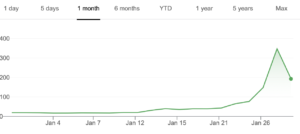This may be the easiest blog post that I ever write. I’m an expert in pump and dump schemes. Not because I’ve been caught up in them, but because I’ve investigated actual trade data related to pump and dump schemes. I’ve questioned representatives about pump and dump schemes. I’ve questioned firm supervisors about them. I’ve reviewed trade data to identify them and I’ve even looked at the behind the scenes trades that occur.
I want to be clear that this article is my opinion alone.
Why talking about Pump and Dump schemes is timely.
Historically, pump and dump schemes have been synonymous with low-priced, thinly-traded securities that are listed over-the-counter (a fancy way of saying not listed on an exchange such as the NASDAQ or NYSE). In the past few years, pump and dump schemes have inched their way into stocks that are listed, but are still low-priced and have trading volume, which could result in them being de-listed (i.e. the stock moves to being traded over-the-counter instead of on the NASDAQ).
Just last week, though, we saw pump and dump activity take a turn and happen in name-brand companies that were listed on the NYSE. The magnitude of the activity, though, was quite astounding, and the people promoting the stocks were doing so under, what I would call, a guise that they were sticking it to hedge funds.
This is the stock chart of one of the stocks I’m referencing:

As you can see from the chart, on January 12, the stock price started increasing, and by January 26 word truly got out about buying shares of this stock. The person pushing people to buy the stock wanted to bring awareness to hedge funds that were betting on this company going bankrupt.
What that means is that hedge funds were buying options, calls specifically, on this stock, as they expected that the value of the company would go down over time. See, this company had not had positive earnings for around three years. So, it was a pretty safe bet on the part of the hedge funds. This, though, means that retail investors aren’t making money if they hold this stock, but hedge funds do. They make a lot of money – billions across the board on this type of activity.
So, when retail investors started buying, it made the hedge funds have to buy shares to “cover their calls.” The combination of activity increased the demand so significantly the stock was trading over 2 billion shares a day, which is what made the price go up so precipitously at the end.
The problem with encouraging individuals to buy the stock to stick it to the hedge funds is that the underlying company is simply not worth the amount investors are making. When this stock got to a high, this made the company a Fortune 500 company. Simply, this company’s valuation was significantly overstated to the company’s value. Rational investors would not buy shares at that price, except for the individual (and the collective at this point) pushing people to buy shares.
Then market forces happened, broker-dealers began restricting trading, and people realized they had a significant value in a stock that likely wouldn’t go up more. This is when the downward trend happened in the stock price. People started liquidating. When people realized they could sell their shares and pay off their home or student loans, they got out. What happened, though, a significant number of people held shares that were no longer worth what they paid for them.
What is a Pump and Dump Scheme?
So, what is a pump and dump scheme? Pump and dump schemes are illegal because someone promotes a stock using false, misleading, or greatly exaggerated statements. They entice people to buy shares of the stock. Because of an increase in demand for the stock, the price of the stock increases. The individual promoting the stock or perhaps others they’re working with then sell shares once the stock price increases significantly. This is the “dump” part of the scheme. Because they begin liquidating shares, the stock price then begins decreasing (typically significantly) because of the volume they are liquidating. At the end of the day the promoter is able to get out of the stock and make a significant amount of money, while leaving retail investors (or the street) holding a significant number of shares in a company at a loss.
How to Avoid Pump and Dump Schemes
Listen, I found what happened last week extremely fascinating. I watched and I read. But this activity is extremely, extremely risky. You have to expect that every dollar you put in will be lost. While there may have been a few success stories, my guess is there are a lot more stories of people who lost money. Hopefully they didn’t lose the house so to speak, but I’m sure there are some out there.
While it can be enticing, especially after we’ve witnessed it to get in on this latest craze, I want to caution and encourage you not participate in this kind of activity!
It is time in the market matters, not timing the market.
Let’s start with talking about the mental mindset to have when investing. It is time in the market that matters, not timing the market. Research shows that we are irrational when it comes to investing. We buy high and we sell low. Anyone who has bought shares in the last couple of days in these stocks that are being heavily traded likely know the feeling of holding stocks that aren’t what they were purchased for.
Research shows we also feel more attached to stocks we own and hold onto them longer than we should. Women are also more consistent investors and don’t over react to swings in the market. Women are better at staying in the boat.
So, when investing, it’s important to pick securities that we aren’t worried are going to swing drastically. We want securities that are going to grow over time.
Invest in Funds Instead of Individual Stocks to Avoid Pump and Dump Schemes
One way to avoid pump and dump schemes is simply to avoid purchasing individual stocks. In fact, individual stocks are too risky for most mainstream investors. Individual stocks carry a significant amount of diversification risk. If you have all of your money in one or two stocks, if a significant negative event occurs, funds invested may not have time to recover.
Research shows that most investors would best served to invest in low fee index or mutual funds. These instruments are designed to be diversified within themselves. Having low fees means that investors have more money working in the market. While these funds may not be exciting up front, they will be exciting once compounding starts picking up.
Index and mutual funds are also designed to be less volatile than individual stocks. It’s better to be invested in a product that will return 5-6% per annum regularly, versus a stock that has a wide range of annual returns (i.e. -5%, 15%, 2%, in sequential years). The fund that consistently has steady returns will allow compounding to really ramp up.
Stock Price
If you are looking to invest in stocks and want to avoid pump and dump schemes there are a few things that you can watch for: the price of the stock, trading volume, and fake or misleading public news.
Historically, how the stock was listed was a good measure of if a stock could be pumped. However, this has changed in recent years. If a stock has a low price (under $5), there is more of a chance that a pump scheme could be successful. So, if you want to invest in stocks, be careful investing in stocks under $5, especially if there is not much active trading in the security (volume).
Look at Trade Volume
If you’re really wanting to invest in a sock, but think it could be a pump and dump situation, another great place to turn to is the trade volume. This is a representation of how many shares are trading hands each day. You can look at this information on Yahoo Finance. The trend you are looking for is evidence that there is a huge spike in volume. If a stock has little to no trade volume for a long time, then starts to have some activity in the days prior to news about the stock, this should raise up a red flag.
What you’ll see then, is a huge spike in volume (compared to previous trading volume) at the point of the news being released. If you see this pattern, be sure to walk away because once the pump is over and the liquidations begin occurring, the likelihood is great that you’ll be stuck holding a bunch of worthless stock that no one will buy from you.
Be Leery of Information You See on the Internet and Social Media
We are all used to me saying this by now, but it’s true. There is so much information, and most of it isn’t good! We have all seen advertisements or headlines on news sites about there now being a cure for this or that. We’ve also seen people talking about specific stocks on social media. This is how a pump starts. It starts with the publishing of misleading or false information.
Stock companies hire public relations firms just for the purpose of making these ads, putting out news releases, and tweeting about stocks.
What they’re hoping to do is catch people’s attention and get them to buy the stock. They’re hoping other people will run up the stock price, because they already have shares, and are going to sell when it gets to a point that will make them money.
Instead of getting a lot of compensation for public relations aka pumping the stock, these companies typically get compensation and shares. So, the share price going up is what truly makes them money.
Don’t fall for these advertisements and invest and get caught in the pump and dump scheme. If the news is public, the market has likely already begun to react and you coming in a day or two later means you are buying a stock after the market has reacted or near a high. Remember the goal is to buy low, sell high.
For More Information on Investing
There is so much to think about with investing (there is a lot more to it than avoiding pump and dump schemes), it may seem overwhelming; however, there is a simple way to start and to continue investing. Next week MPower’s blog post will focus on how to start investing to grow wealth. If you found this article helpful, and want to learn more about investing wisely, be sure to sign up for MPower Co’s weekly newsletter “Spilling the Financial Tea.” You’ll get weekly blogs like this straight to you inbox, and other important financial and wellbeing information.
This Post was Written by Lea Satterfield

Lea Satterfield is the Founder and CEO of MPower Co. She has worked in securities regulation for over a decade. No, she wasn’t a bodyguard! She audited and investigated people that sold investments across the United States. She studied Personal Financial Planning and Finance in college and through her MBA. She is an expert in finance and specifically investing. She manages MPower Co’s social media pages and often talks about current topics and does regular Q&As. Follow us on Facebook or on Instagram. She will do a happy dance when she sees you follow MPower Co!

